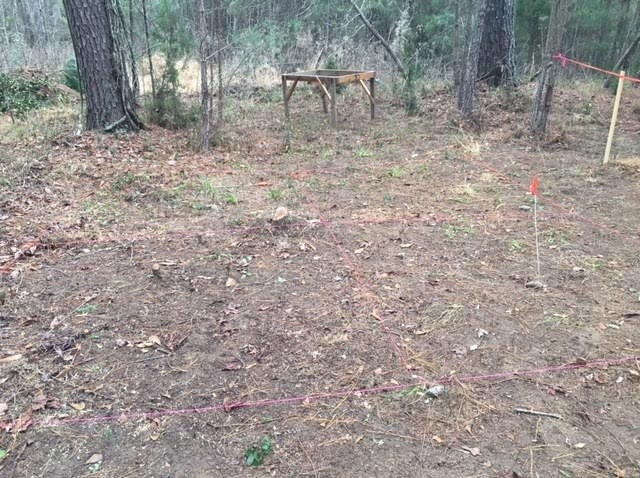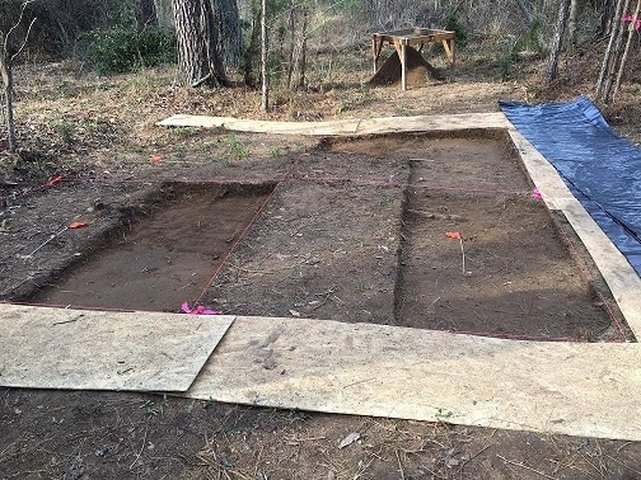|
After spending last week clearing the site, we began learning how to begin excavation. Professor White explained the paperwork needed and the proper way to bag anything we find in the field. We were broken into groups and assigned a unit. Within the unit, we were instructed to begin working on a 1 meter by 1 meter quadrant in this unit. Professor White had set up an elevation datum, and we were instructed to bring this square down to 40 cm below that point. Our square’s starting elevation varied between 30 cm and 33 cm. After marking our square, we used shovels to break ground. Grass and roots made this work difficult. Anything that was removed from the square was placed into a large bucket to be screened. Plywood was placed at the edges of the excavation sites to help protect the walls. The walls are fragile and could crumble if stepped on. Our group found it easier to rotate between shoveling, measuring, and screening. The thickest root in our square was approximately 2 cm, and slowed us down quite a bit. We checked frequently to see if the floor of our square was at 40 cm, and then attempted to flatten it as best we could when we were at the proper level. When this square was completed, we started work on the northern adjacent square. This square was not completed by the end of the day. There is a large stump in the unit north of this square, and another on the west side. These meant very large roots that were too large to be removed with hedge trimmers. However, small roots could be just as troublesome at this level. Sifting the dirt that was removed from the square may have been the most calming job on the field site. We were instructed to keep anything that was not organic. We found several rocks and placed them in a pre-labeled field specimen bag. Our northeastern square also contained a modern rusted metal object of some sort near the area of the large stump. Most of what was screened out was organic material, roots and leaves, because we are working so close to the surface. Paperwork was done to go along with all of this. Each 1m x 1m square was assigned its own form. We record things like starting and ending elevation of the four corners and the center,, a map of the floor, and a detailed description of the soil. These forms are important for tracking everything that comes out of the ground, and even the soil itself. This is necessary because this work can never be done again: when the soil is removed, it can never be put back. These records will be vital to future scientists learning about the site long after the work has been done.
0 Comments
After a week we finally returned for the second day of our field school. During our first visit to the site we had cleared out brush and leaves so that we could set up units, and created a map of the site. Now our second day was beginning and we were actually going to begin digging. We split into three separate groups, one would each take a different 2m x 2m unit. My group and I were assigned to Unit 4. Dr. White decided that we would begin our digging using arbitrary levels. This means that he would set the depth that we were to dig to based up on his own decision and not based upon the stratigraphy. It was decided that we would be digging to 40 cm below our elevation. We figured the distance that we would need to dig down by using a laser level set at the known elevation so measure on a ruler how far below that known elevation we were. Because the laser level is above ground that meant that the ground was already quite close to being 40 cm below the known elevation. For our unit we only needed to dig down about 8-10 cm. After filling out the necessary forms recording all the starting information for our unit we began very carefully to start to scrape off the first level using shovels. We split our 2m x 2m unit into four 1m x 1m units, and excavated each one individually. This proved to be no easy task, as we didn’t want to dig to deep. Once we were close to the appropriate depth we would use trowels to clean up the edges of the unit so that they were straight, and to take off the last little bit to get to 40 cm. Once we had our first 1m x 1m unit done we placed plywood along the outside of the unit to protect the walls. The hope is that we will be able to keep the walls intact throughout the semester. Throughout the course of the day our group managed to finish the first levels of two of our 1 m x 1 m units, and get started on a third. Hopefully next week we will finish out the first level of our complete 2m x 2m unit. Once we finish this first level we will continue going down even further, and very soon will be beneath the topsoil layer. The dirt that was removed from the unit was put into a bucket and taken to a screen we had set up a short distance away. All the dirt was screened and any rocks or other material outside of vegetation that would not sift through the quarter inch mesh was bagged and kept. Our group found several smaller rocks, and even one prehistoric ceramic sherd: the first of what will hopefully be many interesting artifacts over the coming weeks. At the end of the day we took a quick look at the lower part of the site where one of our group was working with Jim Legg, an archaeologist from SCIAA. They had began to carve a unit out of the face of a shelf that had been dug out by a machine earlier, which resulted in the discovery of the site. Here you can see the stratigraphy, and what we will be eventually digging into in the units we worked on today. To end the day we cleaned up all of our tools, and put plastic over the units. The key, we were told, was to "not fight the water." So instead of stretching the plastic tightly over the top, we left plenty of give so that the water would fill up in the plastic and not leak into the units or pull the plastic (and the walls) down.
All in all, it was great second day out at the site, and I feel that we accomplished a good bit for it being the first time actually digging for most of us. Hopefully for the rest of the semester we will continue to have nice weather, and accomplish a lot. |
Student Blog (2017)Blog posts written by the students of the 2017 Broad River Archaeological Field School Archives
April 2017
Categories
All
|











 RSS Feed
RSS Feed
